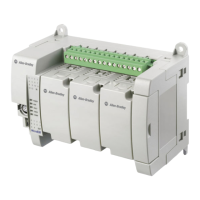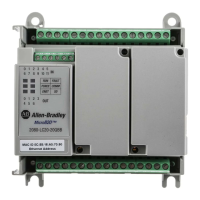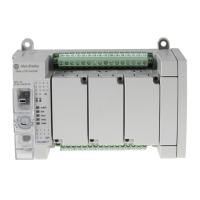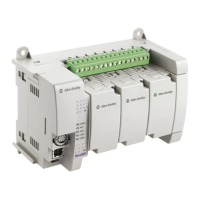Publication 1763-RM001C-EN-P - October 2009
Protocol Configuration 507
Message-Based Polling Mode
Message-based polling mode is best used in networks when
communication with the slave stations is not time critical and where the
user needs to be able to limit when and how often the master station
communicates with each slave station. It is not recommended for larger
systems that require time critical communication between the master and
all the slave stations, or for systems where slave station-initiated messages
are going to be used.
With Message-Based polling mode, the only time a master station
communicates with a slave station is when a message (MSG) instruction in
ladder logic is triggered to that particular slave station’s address. This
polling mode gives the user complete control (through ladder logic) over
when and how often to communicate with each slave station.
If multiple MSG instructions are triggered “simultaneously,” they will be
executed in order, one at a time, to completion (i.e., the first MSG queued
up will be transmitted and completed to done or error before the next
queued up MSG is transmitted). Any time a message is triggered to a slave
station that cannot respond (for instance, if its modem fails), the message
will go through retries and time-outs that will slow down the execution of
all the other queued up messages. The minimum time to message to every
responding slave station increases linearly with the number of slave
stations that cannot respond.
If the Message-based selection is “allow slaves to initiate messages,” a
slave station can initiate a message to the master station (polled report by
exception messaging) or to another slave station (slave-to-slave
messaging). The MSG command packet will remain in that slave station’s
transmit queue until the master station triggers its own MSG command
packet to it (which could be seconds, minutes or hours later, depending
on the master’s ladder logic).
If the Message-based selection is “don’t allow slaves to initiate messages,”
then even if a slave station triggers and queues up a MSG instruction in its
ladder logic, the master station will not process it.
Standard Polling Mode
Standard polling mode is strongly recommended for larger systems that
require time critical communication between the master and all the slave
stations, or for any system where slave station-initiated messages are
going to be used (this includes slave programming over the network,
since this uses the same mechanism that slave-to-slave messaging uses).
The Active Node Table “automatically” keeps track of which slaves are
(and are not) communicating. Standard polling mode should not be used
in cases where the user needs to be able to limit when and how often the
master station communicates with each slave station.
efesotomasyon.com - Allen Bradley,Rockwell,plc,servo,drive
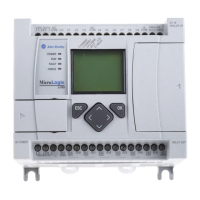
